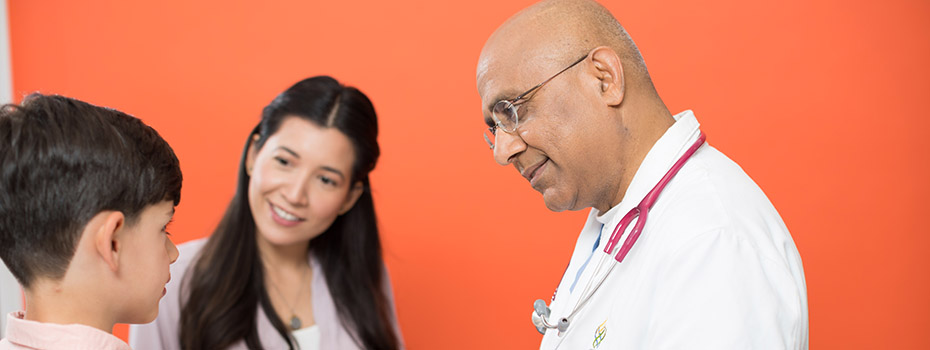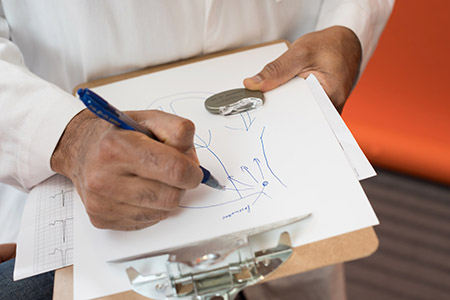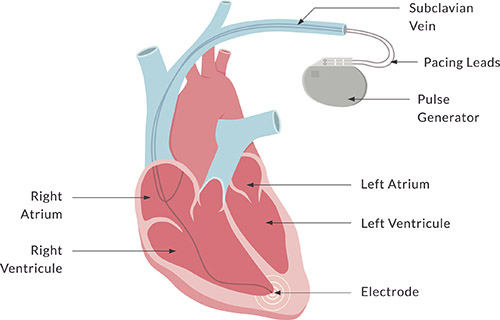Pediatric Electrophysiology and Heart Rhythm Program

OHSU Doernbecher Children’s Hospital offers advanced tests and treatments for heart rhythm conditions (arrhythmias). You’ll find:
- National experts with specialty training and experience in treating children with irregular heart rates.
- Complete, team-based care for complex heart conditions, including arrhythmia.
- High-resolution imaging and 3D mapping that helps us find and treat heart rhythm problems.
- Minimally invasive catheter treatment to stop many arrhythmias.
Complete care
We treat children with irregular heart rates at every stage, from before birth to adulthood. Our team-based approach means we work closely with other OHSU specialists and your child’s pediatrician.
Your care team may include:
- Heart rhythm specialists (electrophysiologists) available 24/7.
- A dedicated nurse and an advanced practice provider (such as a physician assistant or nurse practitioner) to guide your child’s care.
- Surgeons and anesthesiologists who specialize in treating children with heart conditions.
- Heart rhythm specialists with expertise mapping children’s hearts.
Learn more about children’s arrhythmias.
What to expect
If your child has an abnormal heart rate, your child’s pediatrician or cardiologist may recommend a thorough evaluation in our electrophysiology (heart rhythm) clinic. We will schedule your child’s services on the same day when possible.
Diagnosis
We’ll start by doing tests to find the exact cause and location of your child’s irregular heartbeat. Tests may include:
- Electrocardiogram (ECG or EKG)
- Echocardiogram
- Cardiac MRI (magnetic resonance imaging)
- Electrophysiology testing
- The only 3D electroanatomic mapping available in Oregon
- Exercise testing
- Portable monitor
Treatment
Not all arrhythmias need treatment, and many that do are curable. After treatment, children often return to normal activities without needing further care.
Your child’s treatment will depend on:
- The kind of arrhythmia
- The type and severity of symptoms
- How often your child has episodes of arrhythmia
- How long episodes last
Options include:
Medication
A variety of medications can regulate heart rhythm in children. Your child’s care team will talk with you about specific medications, including potential benefits and side effects.
What it does: Medication won’t cure your child’s condition but can manage symptoms. It can return a fast, slow or irregular heart rate to a normal rhythm and keep it steady.
Ablation
Ablation is the most common procedure for heart rhythm problems in children. It is minimally invasive, and it permanently stops irregular beats by disabling the electrical signals that cause them.
How it’s done: The child is asleep during this procedure. An electrophysiologist (a heart doctor who treats heart rhythm conditions) inserts a long, thin tube (catheter) into a vein and guides it to the heart. Radiofrequency energy sent through the tube sears and seals (ablates) the tiny spots in the heart tissue that send abnormal electrical signals.
Our technology: We use 3D electroanatomic mapping to locate the exact spot where the heart’s electrical system is misfiring. We are the only program in Oregon and southwest Washington with this option.
How it helps: It cures most children, avoiding long-term medication use and allowing them to return to regular physical activity.
Our expertise: The providers in our electrophysiology lab combine exceptional experience with state-of-the-art technology.
Cardioversion
In cardioversion, the heart is given a shock to restore it from an abnormally fast rhythm back to a normal rhythm and rate.

Pacemakers and implantable cardioverter defibrillators (ICDs)
A pacemaker is a small (about the size of a matchbox) battery-powered device that is placed in the chest to regulate an abnormal heartbeat. Rarely, a child may also need a small defibrillator (about the size of a pocket watch) to restore a regular heart rhythm.
How they help: A pacemaker sends electrical signals to the heart to make it beat at a normal rate. An ICD constantly monitors the heart and shifts it back into normal rhythm if it starts to beat out of control. ICDs can prevent sudden cardiac arrest in children who have life-threatening arrhythmias.
How they’re placed: A surgeon or an electrophysiologist inserts these devices. The method depends on the child’s size and anatomy. We generally use minimally invasive techniques, with smaller incisions and a faster recovery.
Our expertise: We have an electrophysiologist and two surgeons who are highly skilled at placing pacemakers and ICDs in babies, children and teenagers.
Remote monitoring: Your home monitoring equipment will alert your child’s care team of any problem. We will also review your child’s pacemaker records regularly to check for abnormalities. Most children see us once a year for follow-up care.
Lead extraction: Over time, the wires (leads) that go from the pacemaker or ICD to the heart need to be replaced. We work with experts from OHSU’s Knight Cardiovascular Institute. They use the latest laser techniques to safely remove the wires.

Clinical trials
Our doctors participate in national research studies of children’s heart rhythm problems. They have access to clinical trials and the latest findings through organizations such as SADS Foundation (SADS stands for sudden arrhythmia death syndromes) and the Pediatric and Congenital Electrophysiology Society (PACES). Your care team will talk to you about any trials that might be right for your child.
For families
Call 503-346-0640 to:
- Request an appointment.
- Seek a second opinion.
- Ask questions.
Locations
Parking is free for patients and their visitors.
Doernbecher Children’s Hospital
700 S.W. Campus Drive
Portland, OR 97239
Map and directions
Find other locations across Oregon and in southwest Washington.
Refer a patient
- Refer your patient to OHSU Doernbecher.
- Call 503-346-0644 to seek provider-to-provider advice.